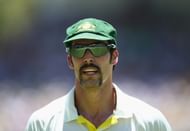In the past few months, there has been a dispute over which bowling attack is the best in the world. There is no denying that the South Africans have been at the forefront of the ICC Test bowling rankings for some time now. However, the Australians proclaimed, after their 5-0 victory over the English, months back, that they have the best bowling attack in the world. Are they really as good as they claim to be?
Firstly, here is a look at the roles that the bowlers play for their respective teams.
The silent wicket-takers:
Ryan Harris vs. Vernon Philander
Bursting on to the cricketing scenes in 2011, Vernon Philander instantly tasted huge success with the red ball in hand. The 28-year-old has taken an incredible 112 wickets at an average of 20.11 in 23 matches to date. He announced his arrival when he took 24 wickets in three Test matches against Australia and Sri Lanka in 2011. The rise was so spectacular that he even occupied the number 1 spot in the ICC Test bowlers’ rankings for a brief period of time, before being pushed to third spot by Dale Steyn and Ryan Harris. Although he has not had a great 2014, bagging only seven wickets in three matches, Philander can be expected to hit his straps sooner rather than later.
Since making his Test debut in 2010 against New Zealand, Ryan Harris has taken 103 wickets at an average of 22.56 in his 24 matches. Harris, who has had to content with recurring knee issues throughout his international career, may not pick up bucketful of wickets, but the world number 2 has a different role to play: with the calibre of Mitchell Johnson and Peter Siddle in the Australian bowling attack, Harris brings with him pressure and consistency that can upset any batsman.
The spinners:
Nathan Lyon vs. Robin Peterson
Making his debut in 2011, Nathan Lyon has taken 112 wickets at an average of 32.99 in 33 matches. The off-spinner took 28 wickets in 8 of the 10 Ashes Tests played in the 2013-14 season. After their painstaking experiments with Jason Krejza, Nathan Hauritz, Xavier Doherty and Ashton Agar, it can be said that the Australians have finally found a wicket-taking spinner in the 26-year-old. The New South Wales spinner has a big future ahead of him in Australian cricket.
Unlike Lyon, South Africa’s Robin Peterson has not tasted success at the Test arena despite making his debut in 2003. The 34-year-old has taken 38 wickets at an average of 37.26. His 4/74 against India in the Boxing Day Test last year is something that stands out of late. He is more suited to the shorter formats. However, he isn’t just a bowler, the Cape Cobra player is quite adept with the bat, as well, which is proved by his batting average of 27.29 in the longer format.
The pacers:
Morne Morkel vs. Peter Siddle
Morne Morkel, in his 56 Test matches, has taken 189 wickets at an average of 30.97. The gentle giant can generate bounce from any surface courtesy of his height, complementing Steyn and Philander’s bowling styles. Bowling at 140kph to 150kph, Morkel plays an integral part in the Proteas line-up.
Making his debut in 2008, Peter Siddle has taken 188 wickets at an average 29.37 in his 53 matches. The vegan fast bowler is notorious for making a class-act in Kevin Pietersen his bunny, having dismissed the English player 10 times in 17 Test matches. He has also had the better of AB de Villiers and Hashim Amla a good number of times. The Victorian bowler doesn’t mind playing second fiddle to Mitchell Johnson; however, that does not mean he is any lesser threat.
The potent strikers:
Mitchell Johnson vs. Dale Steyn
Mitchell Johnson first wore the baggy green in 2007 and has since then played 59 Test matches, taking 264 wickets at an average of 27.42. The left-arm pacer has been a revelation on his second coming to international arena. With 49 wickets at an average of 13.14 in the Ashes home leg, Johnson ran riots in the England line-up. Although not of the same levels, the South Africans encountered troubles facing up to his extreme pace, too.
Dale Steyn, regarded as one of the best bowlers to have ever played the game of cricket, has represented his country in 72 Test matches, taking 362 wickets at an average of 23.01. His ability to bowl fast whilst still swinging the ball on a flat pitch can hardly be executed by an ordinary bowler. The fact that he managed to hold on to his number one ranking for six long years explains his greatness and his value to the team.
Focusing more on the Steyn vs. Johnson comparison, Johnson has taken 22 wickets in the recently concluded three-match Test series against South Africa, whilst Steyn has taken 12 wickets. Johnson may have won this round, but it has to be taken into account that Steyn was pulled out during the third Test, as he sustained a hamstring injury and only bowled a total of 13.1 overs to Johnson’s 53. Which begs the question, what would happen if Steyn or Johnson was not in the squad?
What is even more important is, which team will suffer more without their spearhead? The roles of Harris and Siddle have been undermined by the spotlight on Johnson whereas in South Africa’s case, Morkel and Philander have struggled to make an impact when Dale Steyn doesn’t manage to be amongst the wickets. Based on this and the fact that Australia possess a quality spinner in Lyon, Australia appear to be the best bowling unit in the world at the moment.
Brand-new app in a brand-new avatar! Download Cric Rocket for fast cricket scores, rocket flicks, super notifications and much more!

